Jiamin Li
Network-Assisted Full-Duplex Cell-Free mmWave Networks: Hybrid MIMO Processing and Multi-Agent DRL-Based Power Allocation
Mar 31, 2024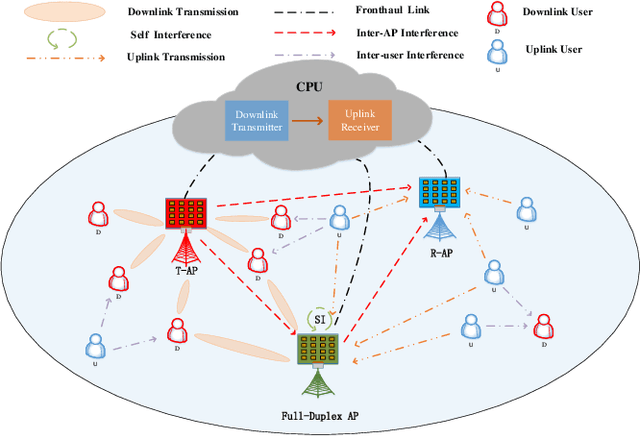
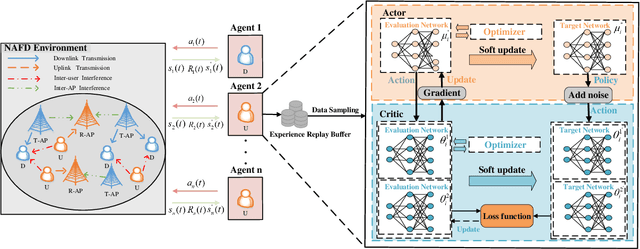
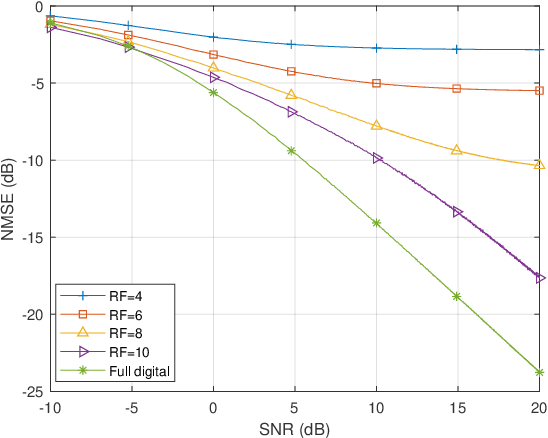
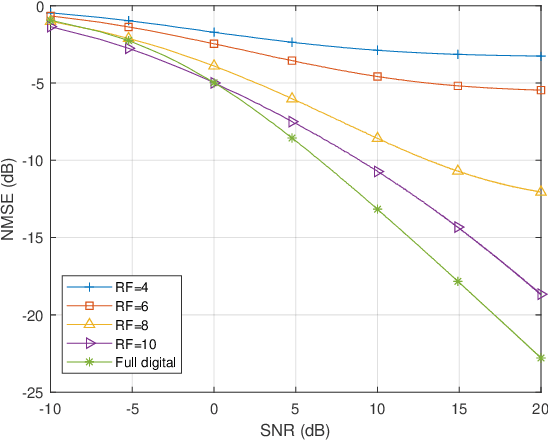
Abstract:This paper investigates the network-assisted full-duplex (NAFD) cell-free millimeter-wave (mmWave) networks, where the distribution of the transmitting access points (T-APs) and receiving access points (R-APs) across distinct geographical locations mitigates cross-link interference, facilitating the attainment of a truly flexible duplex mode. To curtail deployment expenses and power consumption for mmWave band operations, each AP incorporates a hybrid digital-analog structure encompassing precoder/combiner functions. However, this incorporation introduces processing intricacies within channel estimation and precoding/combining design. In this paper, we first present a hybrid multiple-input multiple-output (MIMO) processing framework and derive explicit expressions for both uplink and downlink achievable rates. Then we formulate a power allocation problem to maximize the weighted bidirectional sum rates. To tackle this non-convex problem, we develop a collaborative multi-agent deep reinforcement learning (MADRL) algorithm called multi-agent twin delayed deep deterministic policy gradient (MATD3) for NAFD cell-free mmWave networks. Specifically, given the tightly coupled nature of both uplink and downlink power coefficients in NAFD cell-free mmWave networks, the MATD3 algorithm resolves such coupled conflicts through an interactive learning process between agents and the environment. Finally, the simulation results validate the effectiveness of the proposed channel estimation methods within our hybrid MIMO processing paradigm, and demonstrate that our MATD3 algorithm outperforms both multi-agent deep deterministic policy gradient (MADDPG) and conventional power allocation strategies.
* 14 pages, 9 figures, published on Physical Communication
Integrated Sensing and Communication for Network-Assisted Full-Duplex Cell-Free Distributed Massive MIMO Systems
Nov 13, 2023



Abstract:In this paper, we combine the network-assisted full-duplex (NAFD) technology and distributed radar sensing to implement integrated sensing and communication (ISAC). The ISAC system features both uplink and downlink remote radio units (RRUs) equipped with communication and sensing capabilities. We evaluate the communication and sensing performance of the system using the sum communication rates and the Cramer-Rao lower bound (CRLB), respectively. We compare the performance of the proposed scheme with other ISAC schemes, the result shows that the proposed scheme can provide more stable sensing and better communication performance. Furthermore, we propose two power allocation algorithms to optimize the communication and sensing performance jointly. One algorithm is based on the deep Q-network (DQN) and the other one is based on the non-dominated sorting genetic algorithm II (NSGA-II). The proposed algorithms provide more feasible solutions and achieve better system performance than the equal power allocation algorithm.
Passive Integrated Sensing and Communication Scheme based on RF Fingerprint Information Extraction for Cell-Free RAN
Nov 10, 2023Abstract:This paper investigates how to achieve integrated sensing and communication (ISAC) based on a cell-free radio access network (CF-RAN) architecture with a minimum footprint of communication resources. We propose a new passive sensing scheme. The scheme is based on the radio frequency (RF) fingerprint learning of the RF radio unit (RRU) to build an RF fingerprint library of RRUs. The source RRU is identified by comparing the RF fingerprints carried by the signal at the receiver side. The receiver extracts the channel parameters from the signal and estimates the channel environment, thus locating the reflectors in the environment. The proposed scheme can effectively solve the problem of interference between signals in the same time-frequency domain but in different spatial domains when multiple RRUs jointly serve users in CF-RAN architecture. Simulation results show that the proposed passive ISAC scheme can effectively detect reflector location information in the environment without degrading the communication performance.
Adaptive Gating in Mixture-of-Experts based Language Models
Oct 11, 2023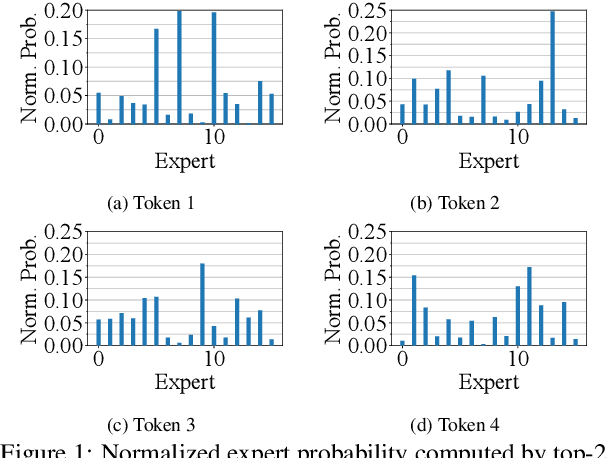
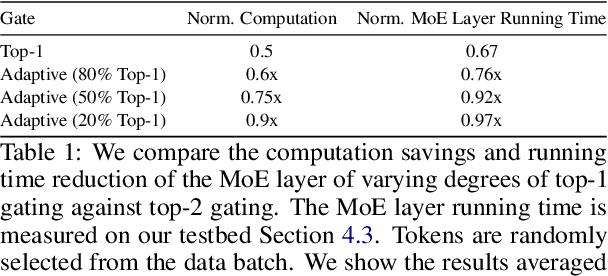

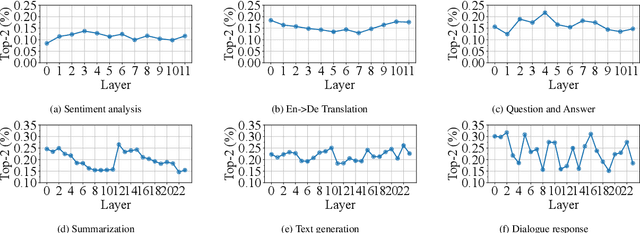
Abstract:Large language models, such as OpenAI's ChatGPT, have demonstrated exceptional language understanding capabilities in various NLP tasks. Sparsely activated mixture-of-experts (MoE) has emerged as a promising solution for scaling models while maintaining a constant number of computational operations. Existing MoE model adopts a fixed gating network where each token is computed by the same number of experts. However, this approach contradicts our intuition that the tokens in each sequence vary in terms of their linguistic complexity and, consequently, require different computational costs. Little is discussed in prior research on the trade-off between computation per token and model performance. This paper introduces adaptive gating in MoE, a flexible training strategy that allows tokens to be processed by a variable number of experts based on expert probability distribution. The proposed framework preserves sparsity while improving training efficiency. Additionally, curriculum learning is leveraged to further reduce training time. Extensive experiments on diverse NLP tasks show that adaptive gating reduces at most 22.5% training time while maintaining inference quality. Moreover, we conduct a comprehensive analysis of the routing decisions and present our insights when adaptive gating is used.
Grouping Method for mmWave Massive MIMO System: Exploitation of Angular Multiplexing Gain
May 25, 2023



Abstract:A future millimeter-wave (mmWave) massive multiple-input and multiple-output (MIMO) system may serve hundreds or thousands of users at the same time; thus, research on multiple access technology is particularly important.Moreover, due to the short-wavelength nature of a mmWave, large-scale arrays are easier to implement than microwaves, while their directivity and sparseness make the physical beamforming effect of precoding more prominent.In consideration of the mmWave angle division multiple access (ADMA) system based on precoding, this paper investigates the influence of the angle distribution on system performance, which is denoted as the angular multiplexing gain.Furthermore, inspired by the above research, we transform the ADMA user grouping problem to maximize the system sum-rate into the inter-user angular spacing equalization problem.Then, the form of the optimal solution for the approximate problem is derived, and the corresponding grouping algorithm is proposed.The simulation results demonstrate that the proposed algorithm performs better than the comparison methods.Finally, a complexity analysis also shows that the proposed algorithm has extremely low complexity.
Network-Assisted Full-Duplex Cell-Free mmWave Massive MIMO Systems with DAC Quantization and Fronthaul Compression
Feb 17, 2023Abstract:In this paper, we investigate network-assisted full-duplex (NAFD) cell-free millimeter-wave (mmWave) massive multiple-input multiple-output (MIMO) systems with digital-to-analog converter (DAC) quantization and fronthaul compression. We propose to maximize the weighted uplink and downlink sum rate by jointly optimizing the power allocation of both the transmitting remote antenna units (T-RAUs) and uplink users and the variances of the downlink and uplink fronthaul compression noises. To deal with this challenging problem, we further apply a successive convex approximation (SCA) method to handle the non-convex bidirectional limited-capacity fronthaul constraints. The simulation results verify the convergence of the proposed SCA-based algorithm and analyze the impact of fronthaul capacity and DAC quantization on the spectral efficiency of the NAFD cell-free mmWave massive MIMO systems. Moreover, some insightful conclusions are obtained through the comparisons of spectral efficiency, which shows that NAFD achieves better performance gains than co-time co-frequency full-duplex cloud radio access network (CCFD C-RAN) in the cases of practical limited-resolution DACs. Specifically, their performance gaps with 8-bit DAC quantization are larger than that with 1-bit DAC quantization, which attains a 5.5-fold improvement.
Spectral Efficiency and Scalability Analysis for Multi-Level Cooperative Cell-Free Massive MIMO Systems
Feb 16, 2023


Abstract:This paper proposes a multi-level cooperative architecture to balance the spectral efficiency and scalability of cell-free massive multiple-input multiple-output (MIMO) systems. In the proposed architecture, spatial expansion units (SEUs) are introduced to avoid a large amount of computation at the access points (APs) and increase the degree of cooperation among APs. We first derive the closed-form expressions of the uplink user achievable rates under multi-level cooperative architecture with maximal ratio combination (MRC) and zero-forcing (ZF) receivers. The accuracy of the closed-form expressions is verified. Moreover, numerical results have demonstrated that the proposed multi-level cooperative architecture achieves a better trade-off between spectral efficiency and scalability than other forms of cell-free massive MIMO architectures.
Optimization of the energy efficiency in Smart Internet of Vehicles assisted by MEC
Jan 14, 2023Abstract:Smart Internet of Vehicles (IoV) as a promising application in Internet of Things (IoT) emerges with the development of the fifth generation mobile communication (5G). Nevertheless, the heterogeneous requirements of sufficient battery capacity, powerful computing ability and energy efficiency for electric vehicles face great challenges due to the explosive data growth in 5G and the sixth generation of mobile communication (6G) networks. In order to alleviate the deficiencies mentioned above, this paper proposes a mobile edge computing (MEC) enabled IoV system, in which electric vehicle nodes (eVNs) upload and download data through an anchor node (AN) which is integrated with a MEC server. Meanwhile, the anchor node transmitters radio signal to electric vehicles with simultaneous wireless information and power transfer (SWIPT) technology so as to compensate the battery limitation of eletric vehicles. Moreover, the spectrum efficiency is further improved by multi-input and multi-output (MIMO) and full-duplex (FD) technologies which is equipped at the anchor node. In consideration of the issues above, we maximize the average energy efficiency of electric vehicles by jointly optimize the CPU frequency, vehicle transmitting power, computing tasks and uplink rate. Since the problem is nonconvex, we propose a novel alternate interior-point iterative scheme (AIIS) under the constraints of computing tasks, energy consumption and time latency. Results and discussion section verifies the effectiveness of the proposed AIIS scheme comparing with the benchmark schemes.
* 17 pages, 9 figures, EURASIP J. Adv. Signal Process
Performance Analysis and Optimization of Network-Assisted Full-Duplex Systems under Low-Resolution ADCs
Dec 17, 2022

Abstract:Network-assisted full-duplex (NAFD) distributed massive multiple input multiple output (M-MIMO) enables the in-band full-duplex with existing half-duplex devices at the network level, which exceptionally improves spectral efficiency. This paper analyzes the impact of low-resolution analog-to-digital converters (ADCs) on NAFD distributed M-MIMO and designs an efficient bit allocation algorithm for low-resolution ADCs. The beamforming training mechanism relieves the heavy pilot overhead for channel estimation, which remarkably enhances system performance by guiding the interference cancellation and coherence detection. Furthermore, closed-form expressions for spectral and energy efficiency with low-resolution ADCs are derived. The multi-objective optimization problem (MOOP) for spectral and energy efficiency is solved by the deep Q network and the non-dominated sorting genetic algorithm II. The simulation results corroborate the theoretical derivation and verify the effectiveness of introducing low-resolution ADCs in NAFD distributed M-MIMO systems. Meanwhile, a set of Pareto-optimal solutions for ADC accuracy flexibly provide guidelines for deploying in a practical NAFD distributed M-MIMO system.
Low Altitude 3-D Coverage Performance Analysis in Cell-Free Distributed Collaborative Massive MIMO Systems
Jun 28, 2022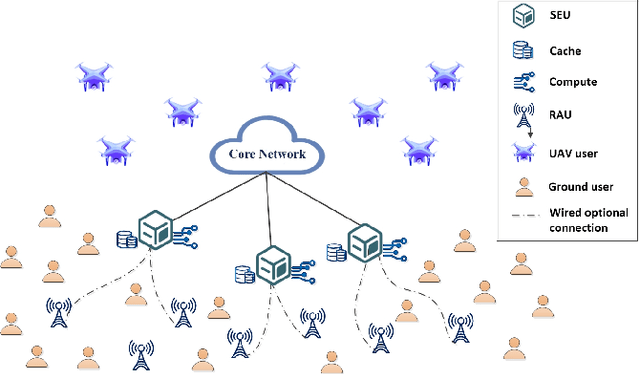
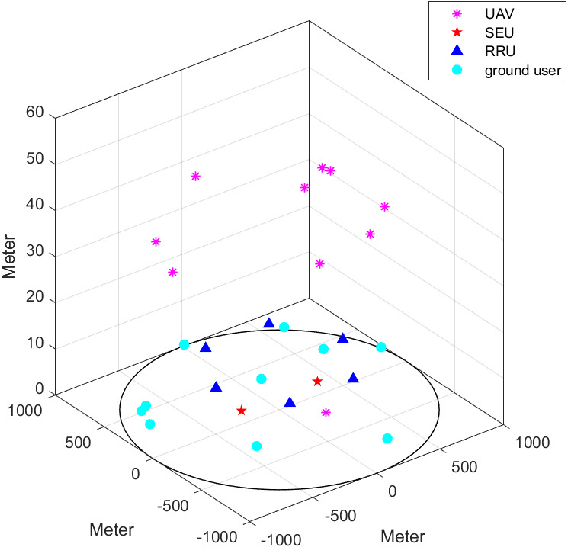
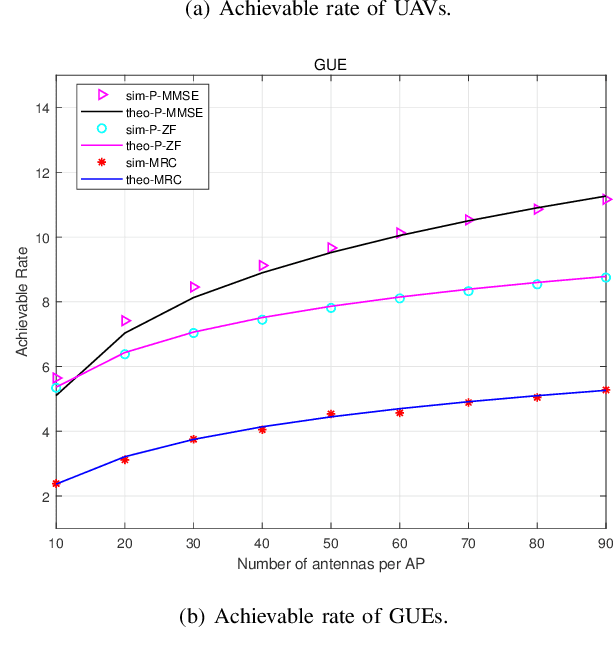
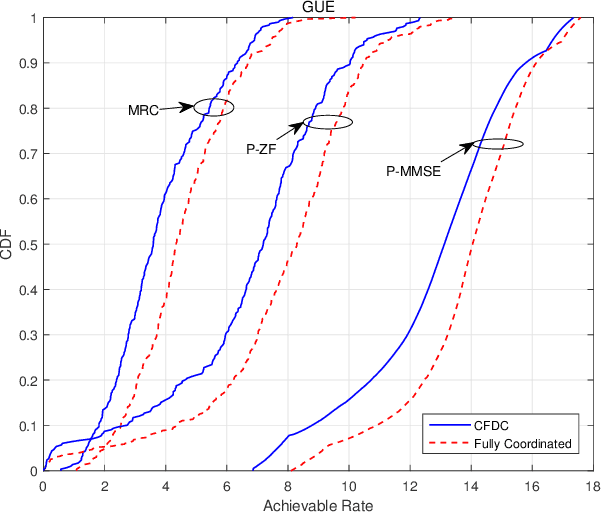
Abstract:To improve the poor performance of distributed operation and non-scalability of centralized operation in traditional cell-free massive MIMO, we propose a cell-free distributed collaborative (CFDC) massive multiple-input multiple-output (MIMO) system based on a novel two-layer model to take advantages of the distributed cloud-edge-end collaborative architecture in beyond 5G (B5G) internet of things (IoT) environment to provide strong flexibility and scalability. We further ultilize the proposed CFDC massive MIMO system to support the low altitude three-dimensional (3-D) coverage scenario with unmanned aerial vehicles (UAVs), while accounting for 3-D Rician channel estimation, user-centric association and different scalable receiving schemes. Since coexisted UAVs and ground users (GUEs) cause greater interference, we ultilize user-centric association strategy and minimum-mean-square error (MMSE) channel state information (CSI) estimation to obtain the estimated CSI of UAVs and GUEs. Under the CFDC scenarios, scalable receiving schemes as maximum ratio combing (MRC), partial zero-forcing (P-ZF) and partial minimum-mean-square error (P-MMSE) can be performed at edge servers and the closed-form expressions for uplink spectral efficiency (SE) are derived. Based on the derived expressions, we propose an efficient power control algorithm by solving a multi-objective optimization problem (MOOP) between maximizing the average SE of UAVs and GUEs simultaneously with Deep Q-Network (DQN). Numerical results verify the accuracy of the derived closed-form expressions and the effectiveness of the coexisted UAVs and GUEs transmission scheme in CFDC massive MIMO systems. The SE analysis under various system parameters offers numerous flexibilities for system optimization.
 Add to Chrome
Add to Chrome Add to Firefox
Add to Firefox Add to Edge
Add to Edge